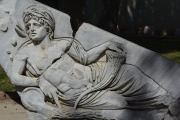We left the village of Pamulkkale in the morning and made the short hop to the ancient hot springs nearby and the adjacent site of Hieropolis. The hot springs were tiered levels that have deposited white layers of travertine, a white residue that looks like ice which is formed from the calcium and carbon dioxide. There are little areas along the tiers were you can bathe or just sit there with your feet in the water.
As wonderful as this was, I quickly left this area and moved on to the fascinating Hieropolis, which is next to it. I read about this place on line, so I was particularly interested in seeing it. Aside from the dominant structure of the amphitheatre, there are ruins spaced over a wide area. In fact, it wasn’t until I only had 30 minutes left to get back to the bus, that I realized there were more on the far end of the site. I raced through as much as I could and made a quick tour of the Seljuk Turk fortress on the way back. Certainly an interesting area well-worth a longer stay.
After lunch, we were off through the beautiful Taurus Mountains bound for Antalya, on the Mediterranean coast. The long drive was made all the more pleasant thanks to Irv, a retired pharmacist who had a repetoire of off-color jokes as good as his delivery for those of us who had rotated our seat placement to the back of the bus that day!
However, before we got to Antalya, we made a stop at a real surprise of a place called, Perge. I couldn’t believe that we got there at the perfect time of the day as the late afternoon sunlight made the ruins glow! Perge was started by Greek colonists around 1100 BC and got a boost from Alexander the Great who passed by on his way to conquering the Persians. But, like many of the ancient sites, it was finally abandoned due to frequent earthquakes.
Antalya, located on the Mediterranean Sea is quite a livable place! The hotel was located quite a way out of the town. The next day, some of us went on a boat ride of the harbor and just relaxed.
In the afternoon we took a trip to see the wonderful Roman theatre at Aspendos. The highlight was when we were there, a Turk came in and started to sing a powerful Turkish traditional song. I thought he would only do it for a few seconds, but he just went on. I wish I had recorded him as the sound reverberated through the theatre due to the incredible acoustics!
We then went to a museum that contained a lot of artifacts from Perge. The fineness of the objects made me appreciate that place even more. At night I went on a little expedition to take some photos of the sunset along the cliff overlooking Antalya harbor. Well, I then heard the clang of a bell and turned to see a tram! So of course, I hopped on and went into the town to check it out. I lost sense of time as the area I got off in was a very “happening” place called Kale Kapisi! I did manage to make it back to the hotel in time to have dinner with some friends from the tour! Good thing I can still walk fast!
Our next destination was Konya, the old capital of the Seljuk Turk empire. It was also an important stop on the Spice and Silk Route between China and Europe in the late Middle Ages. As relaxed as Antalya seemed to be, Konya was not. It is a university town but the atmosphere is not the keg-o-brewski of our college towns! This is a rather conservative Moslem place. There are those who approach tourists hoping to convert them! One bright spot was that this is where Rumi, the mystic and philosopher lived and is buried in a mausoleum. It is quite an impressive structure. This is also, therefore, the religious home of the Sufi sect. They are very connected to service and preserving the earth. Right now, they are helping out on the Syrian border. I was not sad that we left Konya. In the morning a grey, smoky haze drifted over the city from the coal-burning heaters that are used extensively there. It really gets into your lungs.
We stopped near Konya for a lunch at an old Ottoman house in a small village called, Bucak Alem. We ate al fresco at long tables and enjoyed all locally grown vegetables and the most incredible homemade bread. After lunch, I wandered the town a bit and ended up in the nearly little market they have. The women of the village sell their lacework here. I couldn’t believe that work that fine was being sold for next to nothing. Guess they haven’t been spoiled by the tourist trade yet



























Just wonderful!!
LikeLike
I wish was there!
LikeLike
Nice going Paul. The photos are outstanding and your narrative matches the photos.All is well back at the ranch!
LikeLike
That doesn’t look nearly as exciting as studying RIT ranges! 🙂 Looks like you’re having fun!
LikeLike
Hi Paul,
I love the Blog. Keep those pictures and stories coming. Beats the heck out of bus duty and testing!
LikeLike
Pics are beautiful and the Eggplant looks Yummy!!
LikeLike
Amazing photos! Thanks for sharing your journey and for the beautiful postcard. Have fun, stay safe.
LikeLike